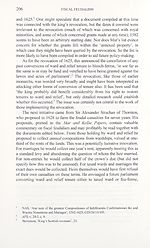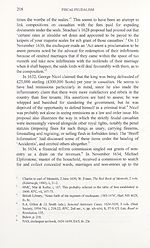Series 5 > Miscellany [of the Scottish History Society] XIII
(222) Page 207
Download files
Complete book:
Individual page:
Thumbnail gallery: Grid view | List view

MISCELLANY XIII
207
apparently with the idea that the dues would be fixed at more substantial
sums than had usually been granted hitherto.1
Strachan’s proposal had considerable fiscal potential. He claimed that
it would not damage the heirs themselves—he was only going to cream
off a third of their rents, whereas at present a donator could appropriate
the whole lot. It is true that the main losers would have been donators to
casualties, but these were often the heirs themselves or their families. The
net result would have been a regularisation of feudal transactions but a
substantial transfer of resources from landed society to the crown. In the
event the proposal was condemned as ‘most pernicious to his majestic
and the best of his subjects’ by the treasurer depute, Lord Napier, who in
his self-important memoirs claimed sole credit for having it withdrawn.2
Strachan then turned to an alternative project, receiving in November
1628 a commission to collect omissions and concealments in treasury
revenues due before March 1628.3 In 1630, when this commission ran
into trouble, he returned to the feudal casualties project, offering once
more ‘to performe that motion which I formerlie made concerning ... the
wards, manages, releeves and non entries’, offering to pay the crown
£2,000 sterling (£24,000 Scots) per year, and claiming that this revenue
had not exceeded £1,500 for the last three years. This was similar to his
previous project except that he would collect only a fifth of the rents for
untaxed wards instead of a third. The proposal was again not taken up.4
Some notes may be offered on the development of policy in the
1630s. One of the things that Charles wanted the convention of estates to
establish in 1630 was ‘that the caswalties of the crowne pay at least three
1 HMC, Mar & Kellie, i, 163-8. It was later stated that Strachan had claimed that the
crown would receive £5,000 sterling (£60,000 Scots) from the project: ibid., 179.
2 Archibald, first Lord Napier, Memoirs (Edinburgh, 1793), 24-6.
3 This commission had a stormy history and was eventually cancelled in Nov. 1630. For
this commission see M. Lee, The Road to Revolution: Scotland, 1625-1637 (Urbana, 111.,
1985), 84-5. There is more detail in A.I. Machines, Charles I and the Making of the
Covenanting Movement, 1635-1641 (Edinburgh, 1991), 68-9, 93-4, but this account
unfortunately includes details from the rejected feudal casualties project (such as the
figure of £24,000 to be raised from the casualties) within its account of the operational
omissions and concealments commission. Nor is it clear that either the feudal Casualties
project or the omissions and concealments commission were ‘an aspect of the
Revocation Scheme’. This book does however provide valuable context for
understanding policy on the feudal casualties.
4 NAS, Strachan to Charles, n.d. [early 1630], GD22/3/777.
207
apparently with the idea that the dues would be fixed at more substantial
sums than had usually been granted hitherto.1
Strachan’s proposal had considerable fiscal potential. He claimed that
it would not damage the heirs themselves—he was only going to cream
off a third of their rents, whereas at present a donator could appropriate
the whole lot. It is true that the main losers would have been donators to
casualties, but these were often the heirs themselves or their families. The
net result would have been a regularisation of feudal transactions but a
substantial transfer of resources from landed society to the crown. In the
event the proposal was condemned as ‘most pernicious to his majestic
and the best of his subjects’ by the treasurer depute, Lord Napier, who in
his self-important memoirs claimed sole credit for having it withdrawn.2
Strachan then turned to an alternative project, receiving in November
1628 a commission to collect omissions and concealments in treasury
revenues due before March 1628.3 In 1630, when this commission ran
into trouble, he returned to the feudal casualties project, offering once
more ‘to performe that motion which I formerlie made concerning ... the
wards, manages, releeves and non entries’, offering to pay the crown
£2,000 sterling (£24,000 Scots) per year, and claiming that this revenue
had not exceeded £1,500 for the last three years. This was similar to his
previous project except that he would collect only a fifth of the rents for
untaxed wards instead of a third. The proposal was again not taken up.4
Some notes may be offered on the development of policy in the
1630s. One of the things that Charles wanted the convention of estates to
establish in 1630 was ‘that the caswalties of the crowne pay at least three
1 HMC, Mar & Kellie, i, 163-8. It was later stated that Strachan had claimed that the
crown would receive £5,000 sterling (£60,000 Scots) from the project: ibid., 179.
2 Archibald, first Lord Napier, Memoirs (Edinburgh, 1793), 24-6.
3 This commission had a stormy history and was eventually cancelled in Nov. 1630. For
this commission see M. Lee, The Road to Revolution: Scotland, 1625-1637 (Urbana, 111.,
1985), 84-5. There is more detail in A.I. Machines, Charles I and the Making of the
Covenanting Movement, 1635-1641 (Edinburgh, 1991), 68-9, 93-4, but this account
unfortunately includes details from the rejected feudal casualties project (such as the
figure of £24,000 to be raised from the casualties) within its account of the operational
omissions and concealments commission. Nor is it clear that either the feudal Casualties
project or the omissions and concealments commission were ‘an aspect of the
Revocation Scheme’. This book does however provide valuable context for
understanding policy on the feudal casualties.
4 NAS, Strachan to Charles, n.d. [early 1630], GD22/3/777.
Set display mode to:
![]() Universal Viewer |
Universal Viewer | ![]() Mirador |
Large image | Transcription
Mirador |
Large image | Transcription
Images and transcriptions on this page, including medium image downloads, may be used under the Creative Commons Attribution 4.0 International Licence unless otherwise stated. ![]()
| Scottish History Society volumes > Series 5 > Miscellany [of the Scottish History Society] XIII > (222) Page 207 |
|---|
| Permanent URL | https://digital.nls.uk/127316193 |
|---|
| Description | Over 180 volumes, published by the Scottish History Society, containing original sources on Scotland's history and people. With a wide range of subjects, the books collectively cover all periods from the 12th to 20th centuries, and reflect changing trends in Scottish history. Sources are accompanied by scholarly interpretation, references and bibliographies. Volumes are usually published annually, and more digitised volumes will be added as they become available. |
|---|


